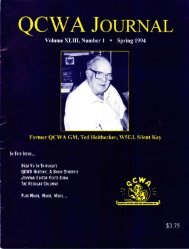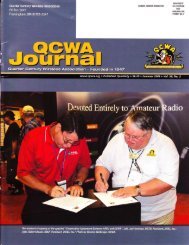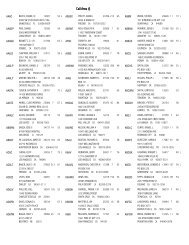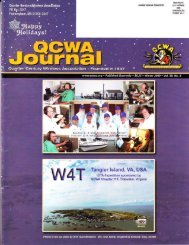G[mloulnal - Quarter Century Wireless Association
G[mloulnal - Quarter Century Wireless Association
G[mloulnal - Quarter Century Wireless Association
You also want an ePaper? Increase the reach of your titles
YUMPU automatically turns print PDFs into web optimized ePapers that Google loves.
Probably one of the greatest changes in Amateur radio since its<br />
beginnings has been in the "home brewing" art. Originally, all amateur<br />
equipment was home brewed. Even as recently as tW\X{lI, most<br />
hams built their own receivers - although owning a store-bought re-<br />
ceiver had become the dream of most everyone. Now on most every<br />
band and QSO, we hear the proud proclamations: "The transmitter<br />
here is an Eidrer Splitter K4\7 and the receiver is a companion SS4R."<br />
This is followed by a description of a store-bought antenna, which is<br />
'different' in that it is almost thirry-four feet in the air. No home brewing<br />
herel \Xihy has Amateur Radio with its long tradition of home<br />
brewing changed so?<br />
There are probably sweral reasons fot this change including, possibly,<br />
our aftluent life sq.le. Aftluence has brought conspicuous consumption<br />
into every facet of our lives, including hobbies. Thus, whether<br />
we have the latest and finest K4\X/ and SS4R combination, or last<br />
years predecessor which had one more vacuum tube, might influence<br />
our position in the "pecking order".<br />
But hams, in general, are individualisdc t)?es who don't consciously<br />
concern themselves with social "pecking orders" and conspicuous<br />
consumption; and it would appear, therefore, that other factors<br />
are involved. lWhat might those factors be? Time? Material? Facilities?<br />
Ingenuity? Perseverance?<br />
What about time?<br />
No one will argue the fact that arnateur transmitters and receivers<br />
of pre tWorld War II were much simpler than their modern day counterparts<br />
and took less time to build. They were so simple, in fact, that<br />
one might "tear down to rebuild on one weekend and be back on the<br />
air widr a brand new rig by the next week end. They were simple, not<br />
just in their circr-ritry but also in their mechanical construction. They<br />
were often built on a pine board; and shielding, if required, was used<br />
to keep the bugs out rather than in. In those days more time was spent<br />
&eaming about the design than in actual construction.<br />
In earlier days therewere enough salvageable parts in an old broadcast<br />
receiver - available to the prospective home brewer for the asking<br />
- to build an excellent 25-watt transmitter and companion receiver.<br />
This was a ty?ical rig - 100 watts was high powerl Additionally, tie<br />
radio parts emporiums were bulging with goodies directly applicable<br />
to arnaterr home brew projects. On the other hand, modern electronic<br />
equipment is so constructed that parts salvaging is almost impossible.<br />
And worse, the majority of surplus parts were designed for<br />
specific applications, generally precluding their use in amateur gear.<br />
That is not to say that new components are not available; howevet the<br />
price in unit quantities desired for home brewing is often prohibitive,<br />
What about facility<br />
Probablythe biggest Actor marking the demise ofthe home brewing<br />
art is the lack of facility by most hams. Vahen the chassis was a pine<br />
board, a few hand tools and the kitchen table for the workbench would<br />
suffice. Today, a reasonably well-equipped wortr





![11{J hI EfifSIt]E I]E - Quarter Century Wireless Association](https://img.yumpu.com/11816560/1/190x245/11j-hi-efifsite-ie-quarter-century-wireless-association.jpg?quality=85)



